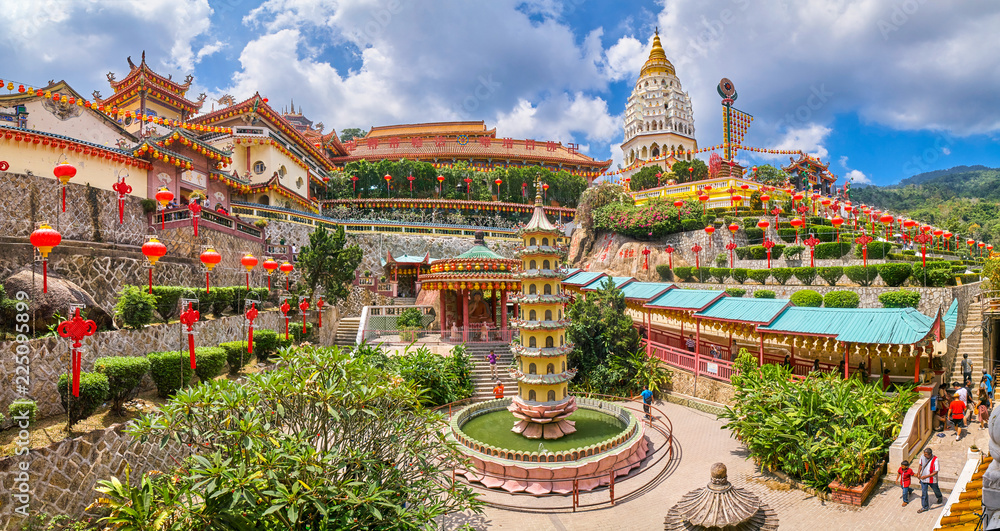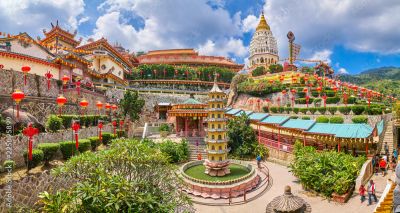

The Pagoda of Rama VI, also known as The Pagoda of Ten Thousand Buddhas, is a prominent structure in the Kek Lok Si Temple, and visitors can spend time exploring its architecture and intricate designs. Standing at 30 meters tall, the pagoda beautifully blends Chinese, Thai, and Burmese architectural styles, symbolizing the harmony of the diverse cultural influences in Malaysia. As you climb the pagoda, you will be greeted by thousands of bronze and stone Buddha statues that line its walls. The ascent offers a spiritual journey through the beautifully crafted stories and teachings of Buddha. Once at the top, you are rewarded with a panoramic view of Penang Island, which is simply breathtaking and provides ample opportunities for contemplation or photography.
The Kek Lok Si Temple, often referred to as the Temple of Supreme Bliss, is one of the most important Buddhist temples in Southeast Asia. As a place of worship, visitors are invited to observe and participate in the spiritual practices and rituals that take place within the temple's sacred halls. The temple complex offers a serene and introspective environment where you can spend time meditating or sending prayers. Devotees often light incense sticks and offer them at the altars, signifying the light of wisdom illuminating the darkness of ignorance. This activity is a profound way to engage with the local culture and religious customs, and it promotes a sense of inner peace and fulfillment.
Kek Lok Si is famously known for its impressive, towering statue of Kuan Yin, the Goddess of Mercy. This monumental bronze statue stands at 30.2 meters high and is a symbol of compassion and benevolence. Visitors can spend time marveling at the scale and craftsmanship of the statue and learning about its cultural significance. The Kuan Yin pavilion, which houses the statue, is an architectural marvel in itself, and guests often take a moment to appreciate its grandeur. Touring this portion of the temple complex can be a spiritually uplifting experience, providing a deeper understanding of Buddhist philosophy and the reverence for Kuan Yin in local traditions.
Surrounding the Kek Lok Si Temple is a bustling market, offering an array of goods, from religious artifacts and souvenirs to local snacks and handicrafts. Visitors can spend time browsing the stalls, where they can find items like prayer beads, incense sticks, intricate Buddha statues, and colorful clothing. The market is a great place to purchase mementos of your visit and to practice your bargaining skills. Engaging with the local vendors provides insight into the lifestyle of the surrounding community, making this activity an enriching cultural experience as well as a retail adventure. Additionally, sampling the local food is a must-do for any culinary enthusiast.
Visiting Kek Lok Si Temple involves a significant amount of walking and climbing stairs, which can be considered an activity in itself. As you make your way through the temple grounds, you ascend a series of staircases that guide you through beautifully landscaped gardens and past towering statues and traditional Chinese lanterns. This physical journey to reach the temple is an opportunity for reflection and anticipation of the spiritual experience that lies ahead. The climb also burns off some calories, making room to enjoy the delicious Penang street food waiting for you at the bottom!
The Hall of Devas is a part of the Kek Lok Si Temple where four heavenly kings, known as Devas, stand guard in the corners of the room, each symbolizing a cardinal direction. This visit allows individuals to immerse themselves in Buddhist cosmology and explore the symbolic meanings behind these majestic statues. The hall is adorned with various other Buddhist figures and fine art, offering a quiet space for contemplation on the teachings of karma and cosmic order. Observing the offerings and rituals performed here can be a serene and humbling experience that adds depth to one's understanding of the religious traditions practiced at Kek Lok Si.
Kek Lok Si Temple offers a wealth of photographic opportunities for visitors. With its vibrant architecture, stunning vistas, and lively markets, photography enthusiasts will have plenty to capture. The temple's elevation on Air Itam mountain provides sweeping views of George Town and the coastline, which are particularly impressive during sunrise or sunset. Photographers may also focus on capturing the intricate details of the temple's design, the expressive faces of the various Buddha statues, or the lively interactions between monks and worshippers. This is a must-do activity for anyone looking to document their travels and the beauty of Malaysian culture.
Exploring Kek Lok Si can build up an appetite, and what better way to satisfy it than by enjoying a vegetarian meal at the temple's food court. Eating vegetarian food is significant in Buddhism as it aligns with the principle of ahimsa, or non-harm. The food court and its variety of stalls present a delightful chance to taste authentic Buddhist vegetarian cuisine, known for its wholesome ingredients and flavorful mock meats. Enjoying a meal here not only provides sustenance for your temple exploration but also offers a moment to dine in a tranquil environment, reflecting on the experiences you've gathered throughout your visit.
The Kek Lok Si Temple is renowned for its vibrant festivals, particularly during the period of Chinese New Year when the temple is illuminated with thousands of lanterns and lights, creating a mesmerizing display. Visitors are welcome to join the festivities, which include special rituals, parades, and cultural performances. Attending one of these festivals offers a deeper appreciation of the temple's role in the local community and Chinese traditions. Experiencing the festivals is a unique opportunity to witness the temple at its most festive, surrounded by the energy and joy of the celebration.
At the foot of Kek Lok Si Temple, there is a large pond known as the Liberation Pond, where visitors can participate in the meaningful practice of 'fang sheng', or releasing animals back into their natural habitat. This pond is home to hundreds of turtles, which you can observe or feed. The act of releasing a captive creature is believed to improve one's karma by saving a life and represents the Buddhist virtues of compassion and mercy. Visitors can take a moment to understand the principles of life liberation, engage in the ritual, and enjoy watching the lively turtles in their aquatic abode.
